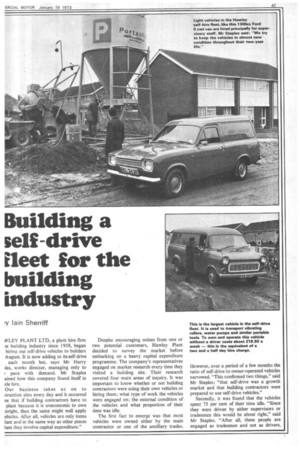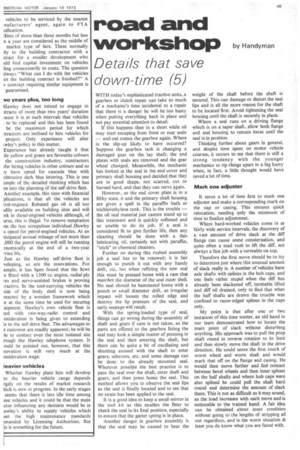Building a self drive Eleet for the building industry
Page 49

Page 50

Page 51

If you've noticed an error in this article please click here to report it so we can fix it.
ly lain Sherriff
NLEY PLANT LTD, a plant hire firm le building industry since 195S, began hiring out self-drive vehicles to builders August. It is now adding to its self-drive each month but, says Mr Harry Iles, works director, managing only to pace with demand. Mr Staples ained how this company found itself in cle hire.
Our business takes us on to ;truction sites every day and it occurred ne that if building contractors have to plant because it is uneconomic to own Aright, then the same might well apply ehicles. After all, vehicles are only items lant and in the same way as other pieces lant they involve capital expenditure." Despite encouraging noises from one or two potential customers, Hawley Plant decided to survey the market before embarking on a heavy capital expenditure programme. The company's representatives engaged on market research every time they visited a building site. Their research covered four main areas of inquiry. It was important to know whether or not building contractors were using their own vehicles or hiring them; what type of work the vehicles were engaged on; the external condition of the vehicles and what proportion of their time was idle.
The first fact to emerge was that most vehicles were owned either by the main contractor or one of the ancillary trades. However, over a period of a few months the ratio of self-drive to owner-operated vehicles narrowed. "This confirmed two things," said Mr Staples; "that self-drive was a growth market and that building contractors were prepared to use self-drive vehicles." Secondly, it was found that the vehicles spent 75 per cent of their time idle. "Since they were driven by either supervisors or tradesmen this would be about right," said Mr Staples. "After all, these people are engaged as tradesmen and not as drivers, but it nevertheless makes for expensive transport."
It became apparent that the greatest area of idle time was in the light van classes. And when this aspect was more closely studied it was seen that the idle time was built up by whole days and that the driving time in many cases occupied only one full day a week. It was not uncommon for the Hawley "reps" to discover vehicles standing for a week at a time without turning a wheel. The third part of the survey concerned the vehicle condition. "Most of them were in a pretty bad state," said Mr Staples, who is a qualified engineer. "Unrepaired accident damage, bald tyres, rust eaten panels and doors, split wings, faulty wiring looms and broken lights were the more obvious faults," he said, "and that was without looking under the bonnet. It was obvious that the vehicles were under-utilized, under-serviced and costing more than they should have done to operate."
The market research completed, Hawley Plant decided to concentrate its attention on the lighter class of vehicles and further research was confined to goods vehicles in the 8cwt to 35cwt class and minibuses. It was felt that this was where the immediate future lay, if indeed there was a future in self-drive hire in the building industry. It now all depended on costs.
200 miles a week The costing aspect was examined, first of all, from the owner-operator's angle. Standing charges were based on a 40-week year which took account of servicing time, five weeks' annual holidays, which includes statutory days, and down-time when weather brings the building industry to a stop. Running costs were based on around 200 miles per week or about 10 hours. This would account for approximately 25 per cent of the tradesmen's time.
Tc own and operate a van in the 8 to lOcwt class based on these calculations without a driver costs approximately £13 per week. The Hawley rate is £20 per week. However, for contractors who were using the vehicle on only one or two days per week Hawley struck a day rate of £4. On the basis of two days' use per week the self-drive vehicles would show a saving of more than £250 a year compared with the owner-operated vehicle and twice that figure if the vehicle was operated on only one day per week. At the other end of the scale, a 35cw is charged at 18 per day. To own operate one without driver's wages is per week. Therefore, unless the vehir actually being driven for more than 54 cent of the week Mr Staples consick much more economic to hire.
While the lighter-type vehicle is use supervisors and tradesmen, the he vehicle is used by companies to dc small hand-tools, lightweight fittings short lengths of timber and the like, to At most, in a well-organized operation type of vehicle should be required one c week. This being the case, the vehic frequently lying idle and inviting use means of personal transport because handy or because lighter vehicles are readily available.
Conversely, the lighter vehicles u should be used for personal tram are frequently employed on can loads for which they were not desil These are blatant examples of mi "Self-drive facilities mean that the hirer engage the vehicle best suited to immediate needs," said Mr Staples, with a consequent saving."
Minibuses in the construction inch are used to transport personnel either a beginning and end of each day or week. The weekly mileage on this tyr work seldom exceeds 200. The Ha Plant hire rates of £6 per day or £30 week are almost identical to the costs o owner-operator without the driver but t are vehicles which Hawley can use for c self-drive work when they are not in sei with the building industry. This is a fat not normally exploited by owner-operr especially in the building industry.
Self-drive hire companies do not del on short-term work for their livelih Hiring by the month or the year or two-year contract is, however, appall proving attractive to customers and h alike. Mr Staples explained: "Few engineering companies have adeql maintenance facilities to cover both requirements of their construction plant a fleet of small vehicles and the far down the ladder you travel the more this is. Hiring companies like ourselves responsible for the maintenance of self-drive vehicles and we ensure that are kept in first-class condition."
FTA servicing Hawley's vehicles are serviced accordance with the FTA servicing sch but, as Mr Staples pointed out, veh engaged on building sites are subjecte, the most arduous working conditions. because of the knowledge gained as a p hirer that Hawley considers itself best fi to meet the demands of this sector of market.
The construction industry in s, respects is highly mobile in that contr are often gained for projects many n from the home base. This can mean tradesmen and supervisors are away f home during the working week and, occasions, at weekends too, for months stretch. In these cases Hawley arranges
vehicles to be serviced by the nearest nufacturers' agent, again to FTA cification.
lires of more than three months but less n a year are considered as the middle of market type of hire. These normally dy to the building contractor with a 'tract for a smaller development who aid find capital investment on vehicles ling unnecessarily to costs. The question dways "What can I do with the vehicles en the building contract is finished?" A ✓ contract requiring similar equipment is guaranteed.
vo years plus, too long Hawley does not intend to engage in rtracts of more than two years' duration ;ause it is at such intervals that vehicles : to be replaced and this has been found be the maximum period for which tractors are inclined to hire vehicles for project. Only experience will alter Lwley's policy in this matter.
Experience has already taught it that ile yellow and green are favourite colours the construction industry, contractors ;fer hiring vehicles in other colours and so IT have opted for cascade blue with obtrusive dark blue lettering. This is one imple of the detailed thinking which has ne into the planning Of the self-drive fleet. Another example, this time with financial plications, is that all the vehicles are trol-engined. Rebated gas oil is all too idily available on building sites and will irk in diesel-engined vehicles although, of urse, this is illegal. To remove temptation m the less scrupulous individual Hawley s opted for petrol-engined vehicles. At an ticipated annual mileage of not more than ,000 the petrol engine will still be running Dnomically at the end of a two-year -vice life.
Just as the Hawley self-drive fleet is veloping, so are the innovations. For ample, it has been found that the 8cwt n fitted with a 1300 cc engine, radial-ply res and servo-assisted brakes is proving :ractive. In the tool-carrying vehicles the ;ide of the body shell is now being otected by a wooden framework which n at the same time be used for securing uipment. Hawley's own vehicle fleet is ted with two-way-radio control and nsideration is being given to extending is to the self-drive fleet. The advantages to e customer are readily apparent; he will be le to contact even the most isolated site rough the Hawley telephone system. It ould be pointed out, however, that this novation is still very much at the ■ nsideration stage.
leavier vehicles Whether Hawley plant hire will develop to the heavier vehicle range depends rgely on the results of market research hich is now in progress. In the early stages seems that there is less idle time among ese vehicles and it could be that the main ctor influencing any decision would be in awley's ability to supply vehicles which eet the high maintenance standards ;manded by Licensing Authorities. But is is something for the future.




















































































































